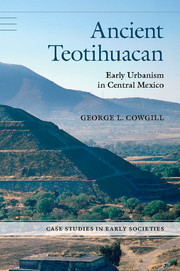Ancient Teotihuacan Early Urbanism in Central Mexico Case Studies in Early Societies Series
Langue : Anglais
Auteur : Cowgill George L.

This is the first comprehensive English-language book on Teotihuacan, the largest city in the Americas before the 1400s.
First comprehensive English-language book on the largest city in the Americas before the 1400s. Teotihuacan is a UNESCO world heritage site, located in highland central Mexico, about twenty-five miles from Mexico City, visited by millions of tourists every year. The book begins with Cuicuilco, a predecessor that arose around 400 BCE, then traces Teotihuacan from its founding in approximately 150 BCE to its collapse around 600 CE. It describes the city's immense pyramids and other elite structures. It also discusses the dwellings and daily lives of commoners, including men, women, and children, and the craft activities of artisans. George L. Cowgill discusses politics, economics, technology, art, religion, and possible reasons for Teotihuacan's rise and fall. Long before the Aztecs and 800 miles from Classic Maya centers, Teotihuacan was part of a broad Mesoamerican tradition but had a distinctive personality that invites comparison with other states and empires of the ancient world.
1. Preliminaries; 2. Situating Teotihuacan; 3. Urbanism begins in central Mexico: 500–100 BCE; 4. Teotihuacan takes off: 100–1 BCE; 5. Teotihuacan supremacy in the basin of Mexico: 1–100 CE; 6. Great pyramids and early grandeur: 100–250 CE; 7. Teotihuacan at its height: 250–550 CE; 8. Teotihuacan ideation and religion: imagery, meanings, and uses; 9. 'Interesting times': Teotihuacan comes apart and a new story begins: after 550 CE; 10. Teotihuacan in a wider perspective.
George L. Cowgill is Emeritus Professor of Anthropology in the School of Human Evolution and Social Change at Arizona State University. He is the director of the ASU-managed archaeological laboratory at Teotihuacan, Mexico. His work on Teotihuacan, anthropological theory, and quantitative methods in archaeology has been published in numerous major peer-reviewed journals. He is co-author, with René Millon and R. Bruce Drewitt, of Urbanization at Teotihuacan, Mexico, Volume 1: The Teotihuacan Map, Part 2: Maps (1973) and co-editor, with Norman Yoffee, of The Collapse of Ancient States and Civilizations (1988). He was the keynote speaker at the fifth Round Table on Teotihuacan at the Instituto Nacional de Antropología e Historia in Mexico in 2011.
Date de parution : 04-2015
Ouvrage de 314 p.
15.2x22.9 cm
Date de parution : 04-2015
Ouvrage de 312 p.
15.2x22.8 cm
© 2024 LAVOISIER S.A.S.



